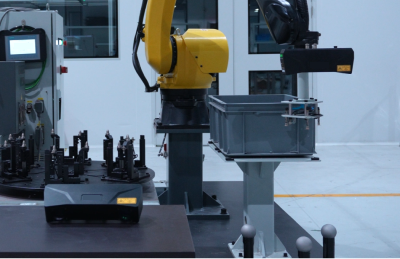Quick Camera Replacement
| This video introduces the quick camera replacement procedure for EIH and ETH scenarios. You may refer only to the quick camera replacement procedure for the EIH scenario. |
In actual production, collisions between the camera and other objects can easily alter its extrinsic parameters. When this occurs, the camera typically needs to be replaced, followed by re-calibration. Alternatively, if replacing the camera is not an option, you can manually set the pick points by jogging the robot. However, both approaches increase workload and downtime.
To resolve this issue, the Quick camera replacement feature is integrated into the “Auto-correct accuracy drift in EIH vision system” tool. The operation workflow is shown below.

-
Migrate configuration parameter group: Mount the new camera and quickly import the configuration parameter group of the old camera into the new one to save time on parameter adjustment.
-
Update camera configuration: After replacing the camera and updating the configuration parameter group, update the configurations related to the camera in the project.
-
Validate image-capturing points: Re-validate the image-capturing points to ensure accurate and reliable drift correction data can be obtained.
-
Test picking: Guide the robot to pick the target object to verify the success of the quick camera replacement.
|
Migrate Configuration Parameter Group
Before replacing the camera, adjust the parameter group of the new camera to ensure that the calibration sphere’s point cloud quality is comparable to that acquired with the old camera. There are two methods to adjust the parameter group of the new camera, and this article will introduce the first method.
-
Import the parameter group from the old camera to the new camera.
-
Directly adjust the parameter group of the new camera.
The second method is suitable when the camera is damaged and cannot be connected. In such cases, mount the new camera directly and proceed with parameter adjustment.
Before replacing the camera, please migrate the configuration parameter group as required, ensuring the configuration parameter group of the old camera is quickly imported to the new camera, thereby reducing the subsequent camera adjustment time.
-
Export the configuration parameter group of the old camera using Mech-Eye Viewer.
-
Disconnect the power and remove the old camera.
-
Mount the new camera, connect the cables, and turn on the power. Ensure that all indicator lights show normal status, then connect to the new camera in Mech-Eye Viewer.
When mounting the new camera, make sure that the mounting height and position of the new camera is the same as that of the old camera.
-
Import the configuration parameter group of the old camera using Mech-Eye Viewer.
After completing the above steps, click Next to proceed with updating the camera configuration.
Update Camera Configuration
After migrating the configuration parameter group, please update the configurations related to the camera in the project.
-
Connect to a new camera. Click Select camera to select and connect to the new camera.
-
Select the serial number of the old camera. Select the serial number of the old camera in the drop-down list.
-
Click the Update configuration button to update the camera configuration.
Validate Image-capturing Points
After replacing the camera, the image-capturing points where the calibration sphere images are captured should be re-validated to obtain accurate and reliable drift correction data.
|
Since the new camera is in a cold-start state, its intrinsic parameter accuracy may change due to temperature increases during image acquisition. Therefore, the camera should be warmed up in advance. Please refer to Warm Up Tool for detailed instructions. |
-
Move the robot to the flange pose corresponding to the image-capturing point.
Please ensure that no collisions occur during the robot’s movement to this pose. It is recommended to jog the robot to the target pose at a low speed and observe whether there will be any collisions.

-
Click Outline and validate to outline the calibration spheres at each image-capturing point, and then click Validate.
The ROI must fully enclose the calibration sphere, leaving a margin equal to the sphere’s diameter on all sides (top, bottom, left, and right). If the message “Failed to locate” appears after outlining the calibration sphere, try expanding the frame range appropriately and reselect the calibration sphere.
Be sure to select the calibration spheres in the same order as defined during the deployment phase.
Once all image-capturing points have been validated, click the Finish button to complete the quick camera replacement process.
Test Picking
Run the robot auto-correction program and picking program. If the robot can successfully pick the target object, the quick camera replacement is considered successful.